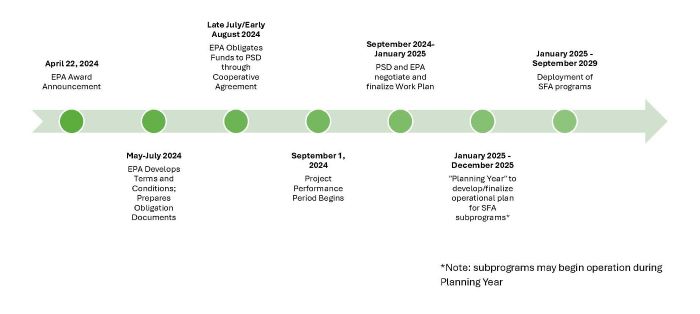Join The Email List For Updates
Improving access to clean, distributed energy for all Vermonters
The Vermont Department of Public Service (PSD) is pleased to announce an award of $62.45 million for Solar for All Vermont (SAV), which will allow low-income Vermonters to access the benefits of solar power. This award is part of the historic $7 billion Solar For All Competition (SFA), which was created under President Biden’s Inflation Reduction Act (IRA) to lower energy costs for families, create jobs, advance environmental justice and tackle the climate crisis.
Solar For All Vermont will allow qualifying low-income households to benefit from clean distributed energy. The program intends to offer three distinct options to Vermonters:
- Residential solar installations for homeowners
- Opportunities for membership in a community solar project
- Benefits for residents of affordable housing
TIMING: The EPA announced awards on April 22, 2024. Grant agreements between states and the EPA will be finalized by September 31, 2024. Benefits for Vermonters are expected to become available in 2025.
PSD intends to solicit public input during the planning phase, beginning in 2024. The planning will include finalizing details of each of the three programs included in SAV, with some programs potentially launching before others. The grant cycle is five years with potential for future expansion.
Funding will establish the Residential Assistance in Solar Energy (RAISE) program and the Multi-Family Affordable Solar Housing (MASH) program. It will also increase funding for the Affordable Community Renewable Energy (ACRE) program.

WHY: Vermont's electric supply is increasingly clean, and while many Vermonters can already produce their own solar power, there have been very limited opportunities for low to moderate-income Vermonters to participate. Allowing all Vermonters the same access to renewable energy advances equity and energy justice.
WHO IS ELIGIBLE: There are several ways to qualify as eligible for Solar for All Vermont programs including:
- Categorical eligibility for recipients of benefits from LIHEAP, 3 SquaresVT, Fuel Assistance, Reach Up, WIC, and possibly other programs;
- Residents of disadvantaged communities as defined by the Climate & Economic Justice Tool, and that are low- or moderate-income households;
- Tenants of properties providing permanently affordable housing;
- VT electric utility customers with household incomes not exceeding 80% AMI or 200% of the Federal Poverty Level (whichever is higher).
HOW: Participating households will either gain direct ownership of a solar installation, or a long-term membership share to a community solar project, with some participants also being able to combine storage with solar. Each subprogram is being designed to offer participants an average monthly bill reduction of at least 20%, with some experiencing even greater savings.
Program funds are expected to be used through each of the following programs:
- RAISE – The Residential Assistance in Solar Energy (RAISE) Program will offer the opportunity for direct ownership of net-metered rooftop solar installations of up to 5 kilowatts to participants. Systems will be financed with subsidized loans through non-profit lenders who will own the system for a 6-year term so that the Investment Tax Credit can be realized through Elective Pay tax provisions of the IRA. Projects will also be subsidized through direct incentives, reducing the amount of the project cost needing to be financed. At the end of the loan term, the ownership of the system will be transferred from the lender to the homeowner, offering years of continued energy savings. Where critical needs can be demonstrated (medical equipment, high-occurrence/long-duration power outages, etc.), storage systems may be included as part of the project for participants. These battery (storage) systems can also provide grid benefits during peak-load events, in addition to backup power for customers during outages. Enabling upgrades are also eligible for this program including roof repairs, structural improvements and electric service enhancements.
- MASH – The Multi-Family Affordable Solar Housing (MASH) Program will sub-award funding to a Multi-Family Affordable Housing organization that can offer grants and/or loans to affordable housing developers. Projects will prioritize roof-top space and available on-site land, where practicable, for the installation of net-metered projects. Additionally, larger-scale projects built remotely will offer energy savings to affordable housing projects through special tariffs through the interconnecting of distribution utilities.
- ACRE – Vermont’s current Affordable Community Renewable Energy (ACRE) Program will be expanded through the funding made available by SAV. ACRE is a grant program that provides federal funding to Vermont distribution utilities (DUs) to create and implement programs that help low-income electric utility customers. ACRE was initially intended to provide economic assistance to Vermonters who were disproportionately harmed by the COVID-19 pandemic. SAV will extend the duration of the program that is currently time-limited by the American Rescue Plan Act (ARPA) funding source. This program extension will offer electric bill reductions through special utility tariffs tied to the production of energy from large-scale solar installations.
Contact us with questions or comments at PSD.SEOSolarForAll@vermont.gov.
July 3, 2024 Solar For All Vermont Program Releases a Request For Proposals
- August 12, 2024. This RFP is now closed and the contract was awarded to VEIC Inc.
- Request For Proposal. The Vermont Public Service Department (PSD) is requesting bids/proposals from qualified contractors to complete the scope of services listed in this request for proposals (RFP) regarding Vermont’s Solar For All (SFA) program funded by the U.S. Environmental Protection Agency (EPA). The PSD’s State Energy Office Division will be the coordinating office for the SFA and for the resulting contract.
- RFP ISSUE DATE July 3, 2024
- QUESTIONS DUE July 10, 2024 – 4:00 PM
- QUESTIONS ANSWERED BY July 15, 2024 – 4:30 PM
- This document lists questions received by the PSD by the July 10th deadline and the PSD's answers to those questions. Questions that were similar are not all listed. Here is the URL for the Q & A document: https://publicservice.vermont.gov/sites/dps/files/documents/Solar%20For%20All_Q%26A%20for%20RFP.pdf
- RFP RESPONSES DUE BY July 25, 2024 – 5:00 PM
=====
To read Vermont’s Solar For All 2023 application to the EPA, click here, or read the executive summary here.
